After all, where else in the Arabian Peninsula combines a beguiling capital, mountains straight from the surface of Mars, sinuous, wind-sculpted deserts, and miles of near-empty beaches, yet remains true to its roots, is easily accessible, and safe? Throw in alluring places to stay (with the prospect of more to come: a clutch of hotel mega-brands are circling Oman, including Four Seasons, Anantara, Kempinski, and Jumeirah, all of whom have properties in the pipeline) and you end up with a destination that’s leapfrogging up a lot of bucket lists.
Furthermore, Oman is arguably the most rewarding place in the region to hire a car, ideally a 4WD: the roads are good; the signs are in English (which is widely spoken); and petrol is cheap (as of writing, a paltry 20p per litre). Check out a few suggestions for an Omani road trip to remember.
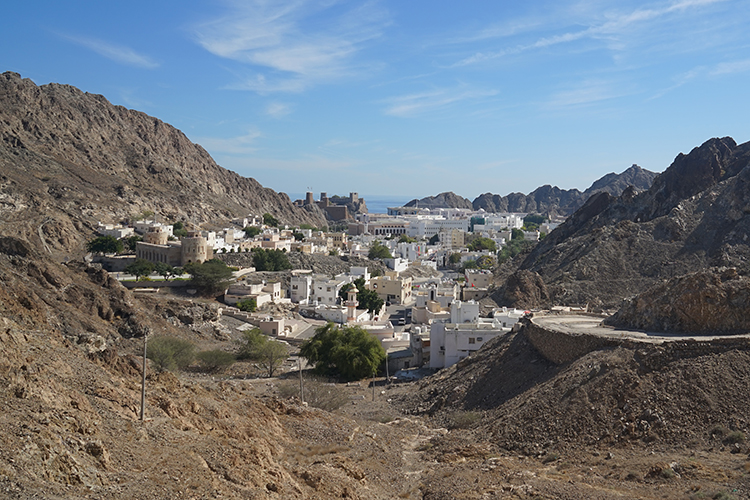
Most international visitors fly into Muscat and it's worth spending a few days in this storied capital before you head for an adventure in the mountains, the desert, or along the coast.
Not for Muscat the high-rise development of neighbouring Dubai; this ancient port city is a chaste counterpoint of whitewashed buildings, where even the humblest structure references traditional Islamic architecture with an arabesque window or a modest dome. Muscat is a modern city where the past lingers pleasingly in the air like a whiff of smouldering frankincense; it's easy to fantasise of an earlier time as locals in dishdashas (robes) and kumas (embroidered caps) make their way to mosques to answer the call to prayer.
The city – comprising the towns of Ruwi, Mutrah, and Old Muscat, plus a straggling conurbation – stretches for 50km along the Arabian Sea; if you’re pressed for time, it's far easier to see the sights on a guided tour rather than brave the heavy traffic on your own. Viator and Oman Day tours organise group and private tours of the city.
What to do
Built to mark the 30th year of Sultan Qaboos’ reign, Muscat’s Grand Mosque is a major city landmark. The restrained exterior – hewn from 300,000 tonnes of Indian sandstone – belies the riches within, particularly in the main prayer hall, where 14m-tall chandeliers sparkle above the world’s second-largest hand-loomed Persian carpet.
The architects behind the Grand Mosque completed another of the city’s must-sees in 2011: the Royal Opera House is the cultural heart of Muscat, hosting a diverse programme of opera, ballet, Islamic and Arabic music, and other performances. If you don’t fancy a show, consider a tour of the magnificent building, which is open to the public for a couple of hours every morning, seven days a week.
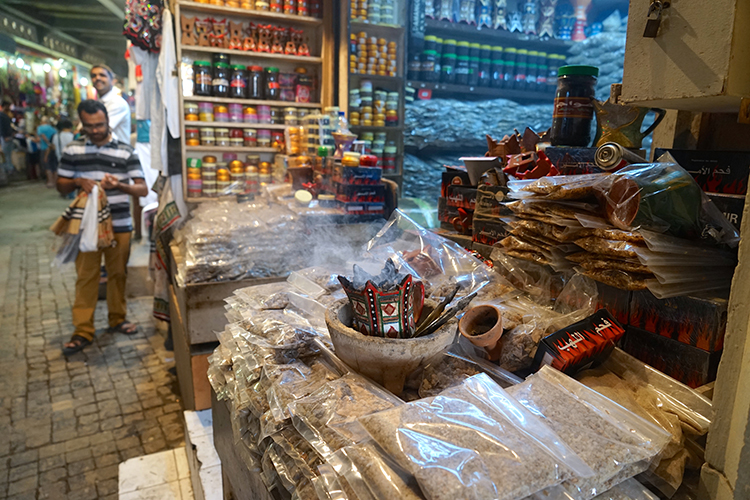
To the east, Mutrah Souk has hummed with trade since long before Portuguese admiral Alfonso de Albuquerque sailed into Muscat in the 16th century; its strip-lit stores sell everything from antique muskets to mosque-shaped alarm clocks. Looking for souvenirs? This is the place to make like the biblical Magi and stock up on supplies of gold, frankincense, and myrrh.
At the other end of Mutrah’s corniche, the fish market is less fragrant but no less atmospheric; visitors can inspect the catch of the day fresh from the Arabian Sea before it finds its way to the city’s commercial and residential kitchens. Take your camera – and hold your nose.
Where to stay
East of Mutrah lies Bandar Jissah, the address of Oman’s biggest, boldest resort. The trio of hotels comprising Shangri-La’s Barr Al Jissah Resort and Spa boast every imaginable facility – from kids' clubs to a dive centre – not to mention a mind-boggling 22 food outlets. Throw in the shuttle to key locations in Muscat and it's easy to see why many people choose to stay here.
From here: Drive west to the Western Al Hajar Mountains.
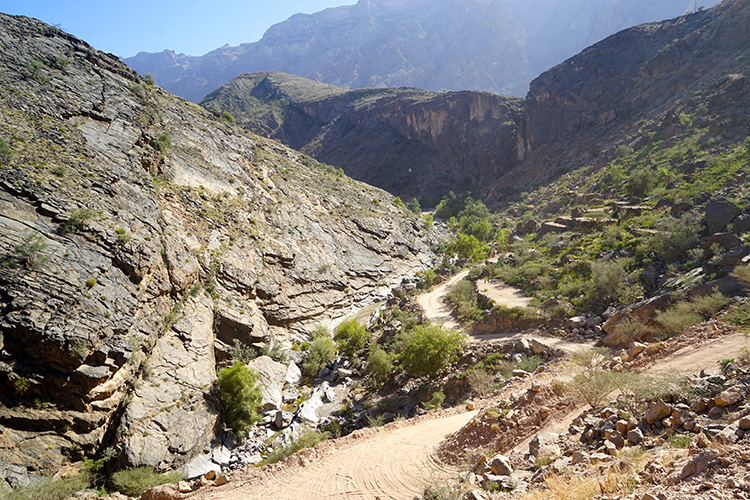
The cost of fuel is not the only reason for the prevalence of 4WDs in Oman: they're a necessity in parts of the country, including the Western Al Hajar Mountains.
At the heart of this range lies dramatic scenery, including Jebel Shams (Oman’s highest mountain at 3075m), Wadi Ghul (Arabia’s answer to the Grand Canyon) and Jebel Akhdar, Arabic for ‘Green Mountain’. Confusingly, the latter refers not to a single mountain at all, but to a region encompassing the Saiq Plateau, whose fecund orchards produce pomegranates, apricots, and other fruit, and the raw ingredients of the local speciality: rosewater.
What to do
Want a true test of nerve? If you’ve got a 4WD and don’t mind driving on the edge – literally – the off-road route between Rushtaq and Al Hamra snakes for 70km through the heart of the mountains.
Narrow, harrowingly steep at times, with vertigo-inducing drops at regular intervals, it isn't for everyone. But unflappable drivers are rewarded with unforgettable panoramas. The route passes through remote territory so take suitable precautions (pack a spare tyre, jack, water, warm clothing, walking shoes, and food and water). Check the weather before you leave and avoid this route during or after rain.
Less intimidating but also eye-popping is the drive up to Jebel Akhdar itself, also a 4WD-only affair (this road is steep and windy, but sealed).
Where to stay
If you're looking for an experience rather than just somewhere to rest rattled bones, check out the Alila . This award-winning hotel clings to the edge of a gorge on the upper plateau of Jebel Akhdar, but the dramatic location isn’t the only reason why it justifies the fanfare (it has featured on a crop of ‘best hotels of 2015’ lists).
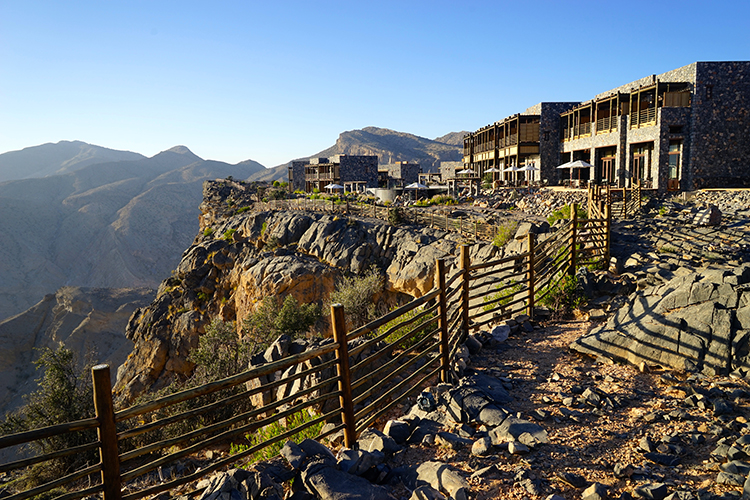
Inspired by Omani forts, the squat buildings are literally made of the mountain – limestone, granite, slate; timber from junipers – and from a distance they vanish into the background. Yet inside, the Alila resembles a gallery of local textiles, metalwork, and art. The hotel is well placed for exploring Jebel Akhdar and organises a range of trips, including hikes to the abandoned villages of Srab and Wadi Ben Habib.
From here: Head southeast to the dunes of Sharqiya Sands.
Shifting Sharqiya Sands covers about 12,500 sq km of eastern Oman. This is the desert as glimpsed in your dreams: a landscape of undulating copper-coloured dunes stretching as far as the eye can see. Apart from small groups of Bedouins encamped in the south, Sharqiya Sands has no permanent settlements. But a handful of desert camps in the north give visitors the chance to spend a night or two amid the dunes.
Again, you’ll need a 4WD to reach most of them from the turn-offs on the Muscat-Sur Hwy at Al-Mintirib or Al-Wasil. Remember to let air out of your tyres at a petrol station beforehand to avoid getting stuck in a sand drift. Camp touts at the turn-offs will also do this for you for a small fee.
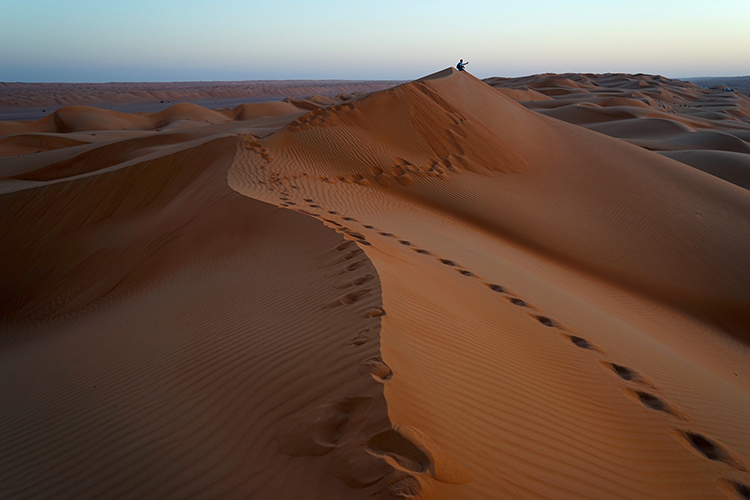
What to do
All the camps offer a range of activities: typically dune-bashing and quad-biking, and the more environmentally sound alternatives of sandboarding, camel and horse rides, or trekking. But the key experience is the simplest and cheapest of them all: just sit atop a dune and watch the sunset. It’s spellbinding.
Where to stay
Don’t expect budget accommodation just because they’re called camps; most of these outfits have posh tents, on-site restaurants, live entertainment, and prices to match. Options include the Desert Nights Camp , or deeper in the dunes, 1000 Nights .
From here: Drive southeast to the coast at Ras Al-Jinz.
Five of the world’s seven species of sea turtle swim in Oman's nutrient-rich waters. Two of them – loggerheads and greens – come ashore to breed. Ras Al-Jinz, the easternmost point of the Arabian Peninsula, is a hotspot for the latter.
Turtles emerge from the Arabian Sea here every night of the year and the government-run Ras Al-Jinz Turtle Reserve protects a nesting site of international importance. The centre runs escorted turtle-watching tours to support their conservation. You’re not guaranteed a sighting, of course, but the odds are good.
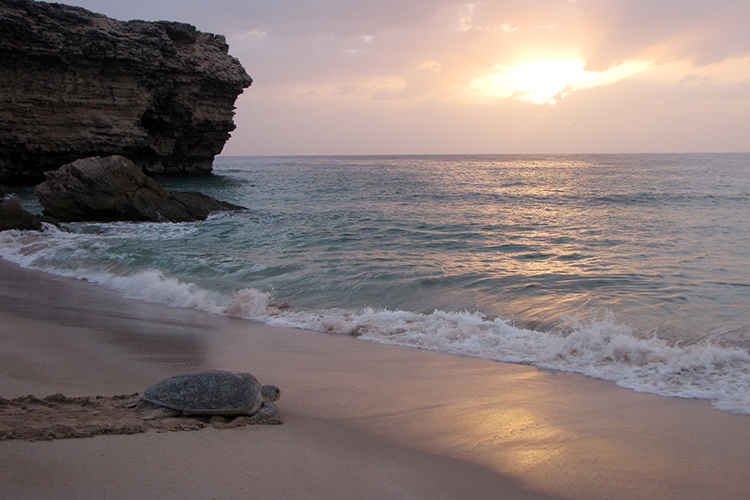
What to do
Manage your expectations. Don't go expecting Life on Earth-style close-ups. Bearing witness to a critical moment in this endangered animal's life cycle is a silent, almost solemn experience, and no less magical for that.
Always listen to your guide and respect the rules – be quiet, stay out of a turtle’s line of sight, and put away your camera when told; a failure to do so could stress out the animals, send them back to the sea, and ultimately jeopardise the species.
Where to stay
From the outside, the visitors’ centre looks unprepossessing, but it conceals a passable hotel with en-suite rooms. The cost of a room includes two turtle-watching trips (one in the evening and a second in the early morning). You can also stay in the reserve in an ‘eco-tent’.
From here: Follow the coastal road north back to Muscat.
It's staggering to think that when the much revered sultan came to power in 1970, Oman had just one sealed road; fast forward 45 years and, among his other accomplishments, the sultan has delivered a network linking all the cities, towns, and many villages.
Like elsewhere in the Arab world, traffic drives on the right. It’s fast and heavy on the expressways around Muscat, and some drivers have a tendency to tailgate at high speed. Away from urban areas the roads are much quieter, and near empty in the mountains.
Be cautious in these areas: camels and goats often wander into the road. Rainfall can cause wadis (dry riverbeds) to flood suddenly. Only drive in the mountains or the desert in a suitably equipped vehicle; take a phone, some essential supplies, and let someone know your plans beforehand.
For more information about Oman visit omantourism.gov.om and destinationoman.com.
Find out more about James' trip through the Western Al Hajar Mountains.
James Kay travelled to Oman with support from Cox & Kings (coxandkings.co.uk). Lonely Planet contributors do not accept freebies in exchange for positive coverage.